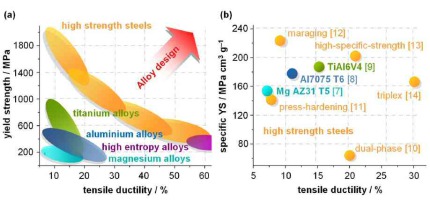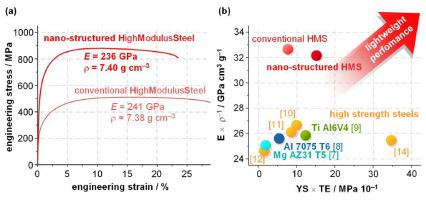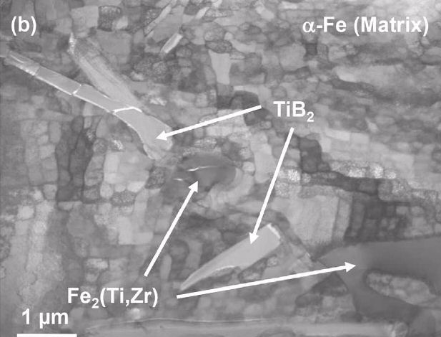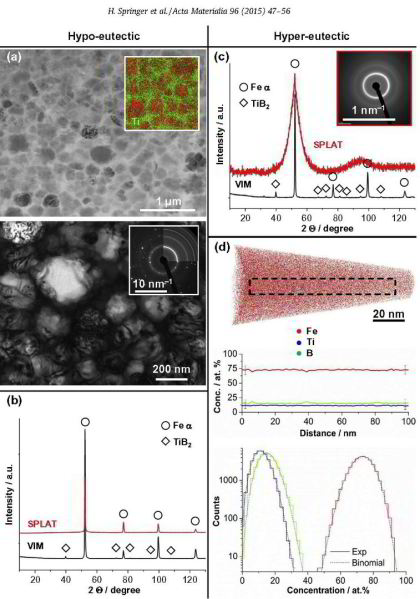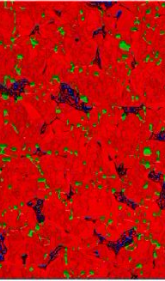HIgh Modulus Metal Matrix Composite Steels
Structural material design aims at shifting technological frontiers by improving physical, chemical and mechanical properties. Among other driving forces such as improved corrosion resistance for longer component life, increased operating parameters for higher efficiency in energy conversion applications and reduction of expensive alloying elements, weight reduction represents a major challenge for example to lower fuel consumption in transportation systems. Steels represent the most common class of high performance structural materials, as their multiple equilibrium and non-equilibrium phase transformations allow
designing a wide spectrum of mechanical properties, and because iron (Fe) based alloys are easy to recycle and very cost-effective. The comparatively high density of Fe (7.86 g /cm^3)
as the basic matrix element of steels, on the other hand, appears at first glance as a negative factor for weight reduction in structural engineering. However, the weight of a
construction element is
determined not only by the density of the chosen material, but also by the parts’ volume, which in turn is resulting from the wall thickness required to avoid rupture and unduly elastic
distortion under load. Ductility, i.e. the ability to undergo plastic deformation, is mainly required for forming operations in the parts’ production, and adds safety in case of
accidental overloading (‘deformation before rupture’) during its service life. Therefore the key properties of structural materials for weight reduced parts maybe defined as (i) high
yield strength in concert with a satisfactory amount of ductility, (ii) low density and (iii) a high Young’s modulus (E) for high component stiffness.
Can we increase the steel's stiffness, strength and ductility and reduce its weight at the same time ? Nano-structured High Modulus Steels
Structural material development for lightweight applications aims at improving the key parameters strength, stiffness and ductility at low density, but these properties are typically mutually
exclusive.
In this project we show how we overcome this trade-off with a new class of nano-structured steel – TiB2 composites synthesised in-situ via bulk metallurgical spray-forming. Owing to the
nano-sized dispersion of the TiB2 particles of extreme stiffness and low density – obtained by the in-situ formation with rapid
solidification kinetics – the new material has the mechanical performance of advanced high strength steels, and a 25% higher stiffness/density ratio than any of the currently used high strength
steels, aluminium, magnesium and titanium alloys. This renders this High Modulus Steel the first densityreduced, high stiffness, high strength and yet ductile material which can be produced
on an industrial scale. Also ideally suited for 3D printing technology, this material addresses all key requirements for high performance and cost effective lightweight design.
Scientific Reports | 7: 2757 | DOI:10.1038/s41598-017-02861-3
Springer_et_al-2017-Scientific_Reports.p[...]
PDF-Dokument [2.7 MB]
How to synthesize MMC steels as Fe-TiB2 high modulus steels through controlled solidification processes for optimal mechanical properties?
We investigated novel pathways to improve the mechanical properties of liquid metallurgy produced Fe-TiB2 based high modulus steels (HMS) by controlled solidification kinetics and subsequent
thermomechanical treatments. The solidification rate was varied by casting of hyper-eutectic alloys (20 vol%
TiB2) into moulds with differing internal thickness. Ingots between 5 and 40 mm thickness exhibited irregular particle microstructure consisting of sharp-edged coarse primary particles
(increasingly clustered with slower solidification) and closely spaced irregular lamellae. Casting defects can be alleviated by hot rolling, but the mechanical properties remain
unsatisfactory. Increasing the solidification rate results only at mould thicknesses of 4 mm and below in a significant refinement of the particle microstructure, necessitating liquid metal
deposition techniques to utilise it for obtained improved mechanical performance of HMS. Decreasing the solidification rate causes density-induced floatation of
the primary particles, which can be used in block-casting for the production of alloys consisting of small and spheroidised eutectic particles, exhibiting high ductility and superior toughness.
Annealing just above the solidus-temperature allows the eutectic zones to liquefy and sink, leaving only primary TiB2
particles behind in the top zone of the alloy. Despite the increased particle fraction up to 24 vol%, both strength, specific modulus and ductility are improved over standard processed HMS
alloys with 20 vol% TiB2.
Acta Materialia 118 (2016) 187-195
Mechanical properties High Modulus Steel[...]
PDF-Dokument [1.7 MB]
What are the effects of alloying and annealing on morphology on high modulus steels?
We systematically study the morphology, size and dispersion of TiB2 particles formed in-situ from Fe-Ti2 based melts, as well as their chemical composition, crystal structure and mechanical
properties. The effects of 5 wt.% additions of Cr, Ni, Co, Mo, W, Mn, Al, Si, V, Ta, Nb and Zr, respectively, as well as
additional annealing treatments, were investigated in order to derive guidelines for the knowledge based alloy design of steels with an increased stiffness/density ratio and sufficiently high
ductility. All alloying elements were found to increase the size of the coarse primary TiB2 particles, while Co led to the most homogeneous size distribution. The size of the eutectic TiB2
constituents was decreased by all alloying
additions except Ni, while their aspect ratio was little affected. No clear relation between chemical composition, crystal structure and mechanical properties of the particles could be observed.
Annealing of the as-cast alloys slightly increased the size of the primary particles, but at the same time strongly
spheroidised the eutectics. Additions of Co and Cr appear thus as the best starting point for designing novel in-situ high modulus metal matrix composite steels, while using Mn in concert with
thermomechanical
processing is most suited to adapt the matrix' microstructure and optimise the particle/ matrix co-deformation processes
Acta Materialia 107 (2016) 38-48
Acta Materialia 107 (2016) 38 In-situ MM[...]
PDF-Dokument [1.9 MB]
Here, microstructures of Fe–TiB2 metal-matrix-composites formed in-situ from Fe–Ti–B melts were investigated for hypo- and hyper-eutectic concentrations down to atomic-scale resolution. Special
emphasis is laid on the influence of the solidification rate on particle size, morphology and distribution as well as their relation to mechanical properties. Innovative routes for the
cost-effective production of stiff and ductile high modulus steels for lightweight structural applications are discussed, focusing on hyper-eutectic compositions due to their high
stiffness/density ratio: firstly, very slow cooling allows the primary particles floating to the top of the cast, from which they can either be easily removed for
retaining bulk material containing only fine-dispersed eutectic particles, or be kept and utilised as a wear resistant surface. Secondly, annealing of amorphous matrix material obtained from
very fast solidification leads to fine dispersed nano-scaled precipitation of TiB2 particles.
Microstructure refinement for high modulus in-situ metal matrix composite steels via controlled solidification of the system Fe–TiB2
Acta Materialia 96 (2015) 47-56
H. Springer, R. Aparicio Fernandez, M.J. Duarte, A. Kostka, D. Raabe
Acta Materialia 96 (2015) 47 Springer hi[...]
PDF-Dokument [3.0 MB]
What is an efficient liquid metallurgy synthesis of Fe–TiB2 high modulus steels?
In this paper we studied the in-situ reduction of Ti oxides by Al as an alternative and cost effective route for the liquid metallurgical synthesis of low density, high stiffness steels (high modulus steels) containing about 10 vol.% TiB2. TiO2, TiO1.83 and TiO were inserted via iron tubes into Fe–B melts, with Al either premixed with the oxide powders or liquid in the melt. Depending on Ti oxide type and location of the redox partner Al, greatly differing reaction kinetics, slag formation and corresponding microstructures of the high modulus steels were observed. TiO1.83 and TiO premixed with Al showed the highest TiB2 yield in the cast steel and are thus favourable candidates for the cost effective production of high modulus steels. Based on our findings, a novel synthesis process is proposed, based on filling wire injection into a continuous casting process, allowing the utilisation of the additionally formed oxide particles for the further improvement of the property profile of high modulus steels.
Materials and Design 97 (2016) 357-363
Efficient liquid metallurgy synthesis of Fe–TiB2 high modulus steels via
in-situ reduction of titanium oxides
Materials and Design 97 (2016) 357 metal[...]
PDF-Dokument [2.5 MB]

